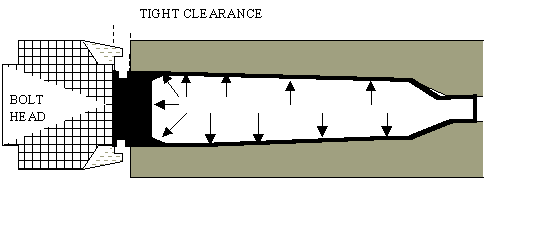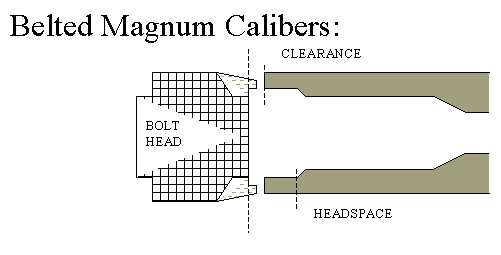Headspace and Head Clearance
What headspace is and why is it so important
When the bolt of a rifle closes on a cartridge the cartridge is must be held tightly. The primer must be kept in a certain position so the firing pin will reliably ignite the primer even though the pin protrudes only hundredths of an inch forward of the bolt face. If there is not enough headspace, the bolt will not be able to close on a given cartridge. Too much and cartridges may misfire, or be inaccurate due to poor ignition by the primer and inconsistent positioning of the bullet relative to the throat.
More important from a safety standpoint is that excessive headspace means cases may stretch to the point of failure. The stretching occurs as the case walls grip the chamber walls on ignition. The unsupported case head is forced backward against the bolt face. If it stretches more than a few thousandths the case head may separate releasing combustion gases and/or leaving the remainder of the case in the chamber.
What head clearance is and why is it even more important.
Head clearance is the amount of the cartridge between the bolt face and the chamber walls. It represents the portion of the cartridge that is unsupported by the rifle barrel. If this value is too great, a portion of the case acted on by chamber pressure will be unsupported and fail, releasing combustion gases.
This figure shows how the case head with proper clearance does not provide a direct path for chamber pressure to escape from the cartridge:

If clearance is excessive, chamber gases can escape as shown in this figure.

Measuring Headspace and Head Clearance, and why everybody always talks about Headspace:
For rimless cartridges, headspace and clearance measurements look like this: (see below for other cartridge types)

Even the most casual shooters know that headspace is measured with a gage (or gages) inserted into the chamber and the bolt closed. It can even be measured by checking fired cases. How is clearance measured? It cannot be directly measured. It is usually measured by checking the protrusion of a headspace gage from the barrel. Another way is to test with shims the clearance between the bolt nose and barrel and adding the depth of the cartridge recess. However, this is not really accurate because chambers are often provided with a chamfer to help with feeding. This adds head clearance as the chamfered area does not support the case head.
So if head clearance is so important, and we canít measure it directly, what are we to do? Well, firearm designers have taken this into account. They have designed rifles such as the Mauser 98 and the Savage 110 that work with clearances well within safe limits. For firearms like these assembled at the factory, headspace is always the more critical dimension. When fitting barrels we can start with safe clearance as a starting point and then shoot for proper headspace.


